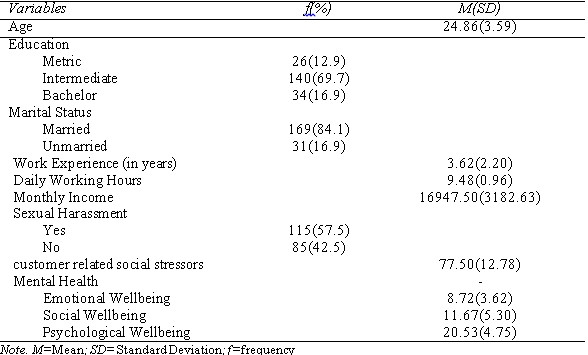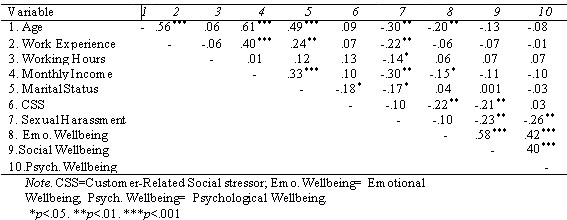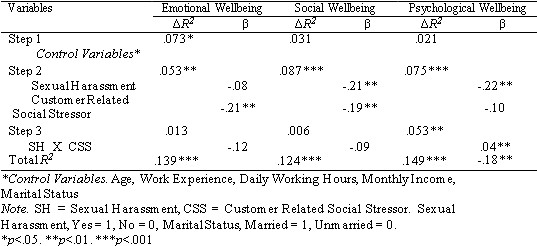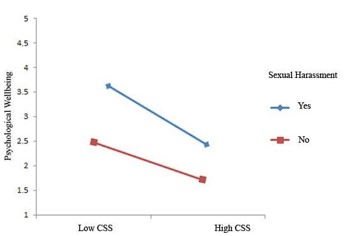Customer Related Social Stressors and Mental Health of Sales Girls: Moderating role of Sexual Harassment
*Muhammad Faran Ali
Department of Applied Psychology, University of Management and Technology, Lahore
Hira Sajjad
Department of Applied Psychology, University of Management and Technology, Lahore
The current study explored the relationship between customer related social stressors and mental health among sales girls by analyzing the dynamics of functioning of sales girls at the job with the customer. The study was conducted using non-probability convenient sample consist of 200 sales girls including evening and morning shift, with the age range of 20 to 35 years (M = 24.86, SD = 3.59) with at least 6 months sales job experience. The data collected from various Malls and shopping centers of Lahore. Customer Related Social Stressors (CSS) and Mental Health Continuum- Short Form (MHC-SF) were used as the data collection instruments. Pearson correlation and regression analysis was employed and the results showed that costumer related social stressors was found to be significantly negatively association with emotional wellbeing and social wellbeing whereas sexual harassment was found to be significantly negatively correlated with Social Wellbeing and Psychological Wellbeing. Sexual Harassment, Customer Related Social stressors and Interaction term of both were found to be negative and significant predictors of psychological wellbeing.
Keywords: customer related social stressors, sexual harassment, mental health, sales girls
In recent years, women active participation in various fields is seen considerably high however, due to societal pressure they come underneath the influence of certain norms and customs (Livingston & Judge, 2008). Women working as a customer service provider experience dehumanization at the job due to inappropriate customer behavior that refers to the violation of norms of conduct by the customer behavioral acts (Morganson & Major, 2014) These behaviors comprise of vandalism, retaliation, and violence, illegitimate complaining, harassment and treating them as an object rather than a person (Keeffe, Bennett, & Tombs, 2006). To meet the customer expectation is perhaps not an easy task and failing to meet their expectations leads to intimidating customer behavior (Goussinsky, 2012). The customer related social stressors plays a significant role in a service provider profession and encountering negative or hostile circumstances at the job would escalate poor mental health among them (Fisk & Neville, 2011). Mental health is referred as a state of well-being where an individual realizes his or her ability to cope with daily life stressors and is able to work effectively to make contribution to the community (Slade, 2010).
Costumer behavior has been vastly researched in business and marketing studies in order to meet and access the emerging demands of the customers effectively (Shobeiri, Laroche, & Mazaheri, 2013) However, the customer behavior plays a significant yet very crucial role for the organizations to meet the rising challenges of today’s world (Srivastava & Kaul, 2014). Meeting the customer demands and reaching their satisfaction level is a hub of every organization dealing with customers that mostly consist of retail business, airlines, hotel industry and call centers to name a few. Yet the customer behavior could be a very fruitful experience for an employee or at the same it could be quite devastating experience for an employee. The customer behavior refers to the attitude or treatment shown by the customers in relation to services provided or exhibit towards the retail company agents (Echchakoui, 2016). Customer behavior is a strong and powerful component of the service culture because failing to bring customer satisfaction would be an inevitable experience of business life (Echchakoui, 2016) and will eventually loses the potential customer. Hence, providing service with a smile and considering the customer rights are the key elements in the service culture. However, that could posit a high strain upon the employees dealing with the customers directly. Employees encountering negative circumstances while dealing with customers such as humiliation, yelling, violation, vandalism, retaliation, violence, illegitimate complaining, disrespect (Keeffe, Bennett, & Tombs, 2006) towards the employee will ultimately leads to poor functioning, low self-esteem, low job satisfaction, poor wellbeing, puts more psychological burden and feel threats to their autonomy and personal control (Echeverri, Salomonson, & Aberg, 2012).
Women are in generally exercise lesser humanness than men (Fredrickson & Roberts, 1997; Haslam, 2006; McKinley & Hyde, 1996) and working as a service provider highly stigmatized their role and leads to dehumanization of them (Haslam, 2006). Dehumanization takes place when one person views the other person merely as a pleasure object rather than human being. Similarly, the high customer entitlement persuades dehumanization, disrespected, objectified or treated as an object among service employees. However, the existing research provide a comprehensive evidence that linked the high customer entitlement with a hostile behavior and facing such circumstances in a working environment would cultivate psychological negative well- being among the service providers (Fisk & Neville, 2011).
Moreover, the high job demand put service providers at a high risk of facing recurrent hostility and enmity from their customers, whom they are required to provide a service with a smile, with displaying suitable emotions at all time (Grandey, Dickter & Sin, 2004) decreased their emotional well-being and thus lead to mental health concerns such as depression, anxiety and stress. Exceeding customer demands triggers negative emotions and effect employee’s mental health adversely (Fisk & Neville, 2011). Customer behavior is one of the chief determinants in a sales profession because it involves a dyadic relationship among the service provider and a customer that primarily involves a set of emotions during the interaction. Due to customer aggression negatively affects the frontline employees psychological well-being including, customer always right, social status, public context and social support.
However, the employees enlist various factors encountering during their duty such as bad customer attitude, poor communication among the management and employees and for not permitting them to eat from the restaurants addresses their work-related problems (Esi, 2012). The research proposed that customer aggression negative affect the employees resulting in stress appraisal, low autonomy, burnout and emotional exhaustion. Employees use surface acting or vented emotions who felt threatened by the customer aggression and those who did not feel threatened used deep acting at the job (Grandey, Dickter, Sin, 2004).
The literature revealed that the women working in factories, hospitals and call centers were seen low on the levels of psychological well-being whereas women working in educational institutes were found to have a high level of psychological well-being and women working in banks were seen at a medium level of psychological well- being moreover it was further revealed that work characteristics of the service providers were associated with low level of well-being and impeded job related attitudes. The service providers experience low control, low autonomy, job uncertainty and task complexity. Moreover, the emotional dissonance was seen as a major stress factor beyond other working conditions (Grebner, Semmer, Faso, Gut, Kalin, & Elfering, 2003). The finding of literature states that, while dealing with the customer aggression the frontline employees perceived threats to self- esteem, equity, sense of control, physical well-being and goal completion at work However, these cognitive appraisal factors negatively affect their psychological well-being in the form of depression, stress and anxiety. Moreover, the study found the four situational factors due to customer aggression negatively affects the frontline employees psychological well-being including, customer always right, social status, public context and social support (Akkawanitcha, Patterson, Buranapin, & Kantabutra, 2015).
The display of certain emotions is an essential aspect of an individual’s job mainly in the customer related services where an employee had to display a set of positive emotions at the job. It has been seen that the emotional dissonance at the job leads to negative outcomes of the employees such as emotional exhaustion and job dissatisfaction. It was found that the expressed and felt emotion by the employees is seen harmful to their well-being (Pugh, Groth, & Thurau, 2010). Lastly, to meet the workplace demand is perhaps not an easy task for the employee. The results of the study stated that the negative social experience at the job and workplace demands particularly related to emotion exhaustion, self-efficacy and job strain promote lower levels of well-being among the employees particularly females. On contrary to this the workplace support was seen as good determinant of promoting increased levels of well-being, self-efficacy, less job strain and higher job satisfaction (Dimotakis, 2011). In Pakistan the sales girls are affected by the harassment of people at their workplaces. A study by Yousaf (2014) stated that women are affected by various acts of harassment ranging from verbal to physical including threats and unwanted advances and such acts affect the girls’ wellbeing as well.
RationaleIn last few years, customer related social stressors has been observed extensively in the study of gender, women empowerment, media influence, etc and its relationship with various indicators of health (Fredrickson, Roberts, 1997; Noll & Fredrickson, 1998; Tiggemann, 2003). Researchers have so far focused on measuring the mental health with customer related stressors while encountering distressing and upsetting events like sexual harassment across the different work settings (Calogero, 2013). However, it is essential to examine the customer behavior and mental health relation with sexual harassment among sales girls. It is pertinent to understand how a salesgirl endorses sexual harassment while encountering with different customer behavior and circumstances at the job by understanding her role in life. This is a significant and well researched question internationally. However, in Pakistan, sales girls are affected by the customer’s behavior as well. In Pakistan, being a sales girl is not considered as a respectable job for women which has affected the morale and overall wellbeing of these girls. Moreover, harassment during their work by the customers negatively affects their wellbeing (Hussain,2009). Furthermore, very little researches are available in Pakistani cultural context to explain the effects of customer related social stressors, sexual harassment and mental health on sales girl.
Objectives of the Study- To investigate relationship between customer related social stressors, sexual harassment and mental health in salesgirls.
- To explore the predictive role of customer related social stressors and sexual harassment on mental health in salesgirls.
- To determine the moderating role of sexual harassment between customer related social stressors and mental health in salesgirls.
- There is likely to be a relationship between customer related social stressors, sexual harassment and mental health in salesgirls.
- Customer related social stressors and sexual harassment will predict mental health in salesgirls.
- Sexual harassment will moderate the relationship between customer related social stressors and mental health in salesgirls.
Method
Research Design
Correlation research design was employed for the current study.
Sample and Sampling TechniqueA total of 200 sales girls (Morning shift=100, Evening shift=100) with thte age range of 20 to 35 years (M = 24.86, SD = 3.59) were included in the study. The data was collected from different malls and shopping centers, by using a non-probability purposive sampling technique.
Table 1Descriptive Statistics of Variables (N=200)

Inclusion and exclusion criteria. At least six month of experience with education at least up to matriculation. Sales girls working in both morning and evening shift were included. Sales girls with any physical disability were not being included in the study and lastly younger than 20 years of age and older than 35 years of age were excluded.
Instruments Demographic Information Sheet provided to the participants that simply consist of age, education, marital status, work experience, working hours, monthly income, family income and harassment experience.
The Customer-Related Social stressor (CSS) by Dormann and Zaff, 2004 is comprised of 21-items. Participants rated this 21-item measure on a 5-point Likert scale from 1=Not at all to 5= Absolutely True. The CSS comprised of four subscales: Disproportionate expectations, Verbal aggression, Ambiguous expectations, and Disliked customers. In the present study, it showed sound psychometric properties, with alpha of .88.
The Mental Health Continuum-Short Form (MHC-SF) by Keyes et al., 2008 is comprised of 14-items. This scale aimed to measure the three components of wellbeing: emotional wellbeing consists of 3 items, social wellbeing consists of 5 items and psychological wellbeing consists of 6 items. Participants rated this 14- item measure on a 6-point Likert scale, from “never” to “every day”. The MHC-SF comprised three subscales: emotional well-being, social well-being and psychological well-being each demonstrating sound psychometric properties, with alpha of .83, .83, and .74, respectively (Lamers, Westerhof, Bohlmeijer, Klooster, & Keyes, 2011). In the present study, the reliabilities of its subscales of scale were .83, .79 and .81 respectively.
Sexual Harassment was measured through a single item (i.e., have you ever been harassed during your job?), using a dichotomous response where 0 indicated = no and 1 indicated = yes.
Procedure To conduct this study the permission to use questionnaires were taken from the authors. Prior permissions were also sought from concerned departments of Lahore. Each participant was personally approached from different stores and malls in break time for their continence to collect data. Individual consent was sought from the participants after explaining the nature and purpose of the research. Questionnaires were personally given to the participants. Only those participants were included who voluntarily and willingly participated in the research. Hence the response rate was hundred percent. It took 10 to 15 minutes to each participants to complete the research protocol. All the queries were answered by the researcher. After data collection, questionnaires were scored and quantitatively measured.
Ethical Considerations
- Permission from department head was taken before commencing the collection of data.
- Informed Consent was taken from the participants that clearly explain the purpose and the nature of the study were explained to the participants with a clear assurance of privacy. The participation in the research was voluntary.
- Keeping in mind the cultural constraints, the rights and welfare of the participants was not being affected.
- Results were reported accurately.
Results
To investigate relationship between customer related social stressors, sexual harassment and mental health in salesgirls, Person product moment correlation analysis was carried out.
Table 2Pearson Product Moment Correlation between Costumer Social Stressor, Harassment and Mental Health (N=200)

Results showed that costumer related social stressors was found to be negatively associated with emotional wellbeing and social wellbeing whereas sexual harassment was found to be negatively correlated with Social Wellbeing and Psychological Wellbeing. Moreover to explore the predictive role of customer behavior and sexual harassment and interaction effect of both variables on mental health in salesgirls, Hierarchical multiple regression analysis was conducted.
Table 3Moderation through Hierarchical Regression Analysis Predicting Mental Health in Sales Girls (N=200)

The results revealed that, after controlling variables in step 1, Sexual Harassment and Customer Related Social Stressors in step 2 and interaction term of sexual harassment and Customer Related Social Stressor were entered in step 3. The overall model explained the 13.9% of variance for emotional wellbeing with F (8, 191) = 6.58, p<.001, whereas Customer Related Social Stressors was found to be significant negative predictor of emotional wellbeing. Moreover the overall model explained 12.4% of variance for social wellbeing with F(8, 191) = 5.75, p<.001 whereas Sexual Harassment and Customer Related Social Stressors both were found to be significant negative predictors of social wellbeing.. Furthermore, for psychological wellbeing the overall model explained 14.9% of variance with F (8, 191) = 7.52.40, p<.001 Sexual Harassment, Customer Related Social and Interaction term of both were found to be negative and significant predictors of psychological wellbeing. (See figure 1).

Plot showed that the relationship between Sexual Harassment and Customer Related Social Stressors become negative if sales girls not experience sexual harassment while the negative relationship between Sexual Harassment and Customer Related Social Stressors become stronger if they experience sexual harassment.
Discussion
The current study reveals that the sexual harassment was found to a negatively significant relationship among social wellbeing and psychological wellbeing of sales girls affecting their mental health Sexual harassment has been extensively researched in workplace over the past few years (Kelly, Sperry, Bates & Lean, 2009). The sexually harassment is practice profoundly in workplaces even in Pakistan and seen as a predictor of low self-esteem and low job satisfaction among working women (Malik, Malik, Qureshi & Atta, 2014). The harassment of employees by customer has been less overtly investigated however some previous researches showed it as significant problem the employees faced especially women during the course of their jobs (Hughes & Tadic, 1998; Harris & Daunt, 2013) and it leads to distress, disruption and workplace conflict (Murphy, Samples, Morales, & Shadbeh, 2015). Similarly, harassment has regularly being practiced in Pakistan and it takes place on daily basis, however both male and females becomes victim of it yet the ratio is seemingly high among women especially those who work outside their homes. Living in a patriarchal society, women victimization or gender inequality are every day debates that comes in many different forms such as harassment, rape, domestic violence, acid attacks, etc because due to the heavy cultural influence the role of women is perceived as more traditional; serving the family, doing house chores and a symbol of affection and care. So from the very beginning both men and women are told about their roles in a society where males reminds of their dominance and women is seen as more fragile and vulnerable being and experiencing such negative social interaction thus decreases social wellbeing and psychological wellbeing among women (Nahum, Bamberger, & Bacharach, 2011; Lincoln, 2015). However, that is one potential explanation of women perceiving and seeing themselves from an external perspective.
Moreover, the customer related social stressors were also found to be significant negative in relation to sales girl’s emotional wellbeing and social wellbeing. According to the prior researches, the interaction among customer and a service provider plays a key role in service job and the customer behavior is always been taking into consideration however, the negative interaction with the customer at the job will decrease employees wellbeing and could leads to emotional exhaustion. In addition, a series of emotions both positive and negative being experienced by the employees yet employees needs to persistently monitor and supervise their emotions in order to achieve the organizational goals (Grandey, 2000; Beal, Trougakos, Weiss, & Green, 2006; Huang, 2016). Therefore, displaying a particular set of emotions and always required to preserve positive customer relations at the job would lead to unnecessary emotional burden and experiencing negative treatment by the customer began endorsing poor wellbeing, poor health, emotional exhaustion and absenteeism among employees (Judge, Woolf, & Hurst, 2009; Grandey, 2000) and receiving positive treatment from the customer has been seen encouraging and strengthens the employees wellbeing (Harris & Reynolds, 2003).
The service culture around the world has been extensively studied and its principles are found to be similar everywhere, where all the organizations dealing with customer services are bound to the ideology of “customer is always right” (Grandey, Dickter & Pengsin, 2004). Dealing with the customer queries puts heavy strain and influence upon the employees making them vulnerable to the customer misbehavior every now and then and also decreases their motivation to work (Grandey, 2000; Ilies & Judge, 2002). Moreover, the service providers feel immense pressure to their self-esteem, wellbeing, sense of control, fairness or equity and goal completion at work while dealing with customer’s inappropriate behavior; providing the service with smile and going beyond to satisfied the customer needs put them on risk of developing psychological issues (Green, 2005).
Last, the interaction between both customer social stressors and mental health showed a significant negative relationship with psychological wellbeing of sales girls. The employees who deal with customers are referred to as emotional labor (Hochschild, 1983) which defines as the process of managing the expressions and feelings at the job as its requirement. During the interaction with the customers the employees are obliged to regulate their emotions and therefore made them suppress their truly felt emotions and expected to display such gesture that contradicts with their true personalities. Hence the job of a service provider opens gates to exploitation and manipulation of the employees by the customers where their true emotions are fully suppressed and withhold in the interests of the organizational profit and customer welfare. However, experiencing these sorts of circumstances would eventually lead to estrangement among their true self and their individuality (Williams, 2013). In addition, employees are required to adjust their roles according to the demands of the working world and due to heavy influence of culture where the role of working women is always been targeted pessimistically women tend to deal with their work values through their bodies and adjusting to their work lives they tend to change understanding of their bodies. Consequently, the bodies become a mechanism of transmitting their values to get along with the working culture (Melendez, 2001).
ConclusionThe future implications of these findings can be that a mixed research design should be used in order to study the same variables in depth like rejection sensitivity and self-esteem along with coping styles. In order to decrease rejection sensitivity, depression, and increase self- esteem, quality of life and improve coping of infertile individuals, psycho-educational programsmay be introduced in the hospitals. A preventive programs can be designed by keeping in view the mental health of infertile individuals an intervention may be designed based on the principles of cognitive behavior therapies to help them cope with the situation of infertility.
References
Akkawanitcha, C., Patterson, P., Buranapin, S., & Kantabutra, S. (2015). Frontline employees’ cognitive appraisals and well-being in the face of customer aggression in an Eastern, collectivist culture. Journal of Services Marketing, 29(4), 268-279. doi:10.1108/JSM-12-2013-0328
Amoako, P. M. E. (2012). The Role Employees Play in Service Delivery to Achieve Customer Satisfaction at the Imperial Perkin Fast Food Restaurant (Doctoral dissertation).
Beal, D. J., Trougakos, J. P., Weiss, H. M., & Green, S. G. (2006). Episodic processes in emotional labor: perceptions of affective delivery and regulation strategies. Journal of Applied Psychology, 91(5), 1053-1065. doi: 10.1037/0021- 9010.91.5.1053
Calogero, R. M. (2013). Objects don’t object: Evidence that self- objectification disrupts women’s social activism. Psychological Science, 24(3), 312-318. doi: 10.1177/0956797612452574
Dimotakis, N. (2011). The Relationship of Work Demands and Resources to Subjective Well-Being: The Role of Self-efficacy and Coping. Journal of Organizational Behavior Human Resource Management, 2(2), 112-342.
Echchakoui, S. (2016). Relationship between sales force reputation and customer behavior: Role of experiential value added by sales force. Journal of Retailing and Consumer Services, 28, 54-66.
Echeverri. P, Salomonson. N & Aberg, A. (2012). Dealing With Customer Misbehavior: Employees’ Tactics, Practical Judgment and Implicit Knowledge. Journal of Marketing Theory, 12(4) 427–449 doi: 10.1177/1470593112457741.
Fredrickson, B L. & Roberts, T. (1997). Objectification theory: Toward Understanding Women's Lived Experiences and Mental Health Risks Psychology of women quarterly 21(2), 173-206. Retrieved from https://s3.amazonaws.com/
Fredrickson, B. L. & Roberts, T.-A. (1997). Objectification Theory. Journal of Psychology of Women Quarterly, 2(2),173–206. doi:10.1111/j.1471-6402.
Goussinsky. R., (2012). Coping with Customer Aggression. Journal of Service Management, 23(2), 170-196.
Hochschild, A. R. (1983). The managed heart: Commercialization of Human Feeling. Berkeley, CA: University of California Press.
Hughes, D. K., and Tadic. V. (1998). ‘Something to Deal With’: Customer Sexual Harassment and Women’s Retail Service Work in Canada. Journal of Gender, Work and Orgaization, 5 (4), 123-458.